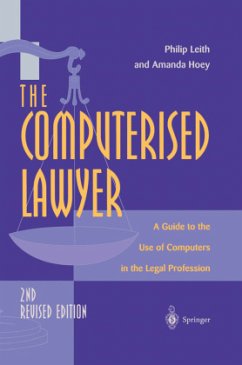The Computerised Lawyer provides a comprehensive introduction to the technology and application of computers in law. Over the last 5 years it has become increasingly recognised that the skills associated with new technology are so important that proficie ncy in the field is now being viewed as an integral element in the education and skills development of all law students. New curriculums are being developed which incorporate the issues discussed in this book, and professionals will find the text useful and highly relevant. This book fulfils the need for a textbook which, whilst assuming no prior knowledge of computing, manages to cover all the key issues associated with information technology and its relevance to legal issues and practice. Philip Leith and Amanda Hoey have completely rewritten the first edition of this book to bring the reader an up-to-date text that will be important to everyone working with computers in law.
Thesecondeditionofthis workdemonstrates how substantiallythe field ofcomputers and law has moved. In the first edition, some 78 pages were givenover to the description ofhardwareand software description - almost an 'introduction to computing' for lawyers. Now, in this edition, the general expertise which exists amongst lawyers and the availability ofgood, easily assimilated information concerning the new technologies allows us to minimise this kind of material and move over to more substantive issues. Students no longer have to be told where the 'return' key is, and lawyers are aware of, for example, practice management software. Not only is the general level of understanding greater, but the computer itself has substantiallydeveloped, partlythroughbecomingmore power ful for lesscost, and partly through the communications revolution known as the 'Internet'. Thishas allowed us to develop areas ofthe first edition which were not looked at due to space reasons: the result is acompletelydifferentbook. The preface to the first introduction made mention of the nega tive view whichlaw teachers generallyhad ofthe role ofcomputers and law within the curriculum. This has changed drastically and it isnow almost universally the case that law schoolsencourage com puter literacy amongst students and almost all staff are computer literate. This student literacy is seen as a skill for a future career, as well as a skill required by the law student during their education.
Hinweis: Dieser Artikel kann nur an eine deutsche Lieferadresse ausgeliefert werden.
Thesecondeditionofthis workdemonstrates how substantiallythe field ofcomputers and law has moved. In the first edition, some 78 pages were givenover to the description ofhardwareand software description - almost an 'introduction to computing' for lawyers. Now, in this edition, the general expertise which exists amongst lawyers and the availability ofgood, easily assimilated information concerning the new technologies allows us to minimise this kind of material and move over to more substantive issues. Students no longer have to be told where the 'return' key is, and lawyers are aware of, for example, practice management software. Not only is the general level of understanding greater, but the computer itself has substantiallydeveloped, partlythroughbecomingmore power ful for lesscost, and partly through the communications revolution known as the 'Internet'. Thishas allowed us to develop areas ofthe first edition which were not looked at due to space reasons: the result is acompletelydifferentbook. The preface to the first introduction made mention of the nega tive view whichlaw teachers generallyhad ofthe role ofcomputers and law within the curriculum. This has changed drastically and it isnow almost universally the case that law schoolsencourage com puter literacy amongst students and almost all staff are computer literate. This student literacy is seen as a skill for a future career, as well as a skill required by the law student during their education.
Hinweis: Dieser Artikel kann nur an eine deutsche Lieferadresse ausgeliefert werden.








